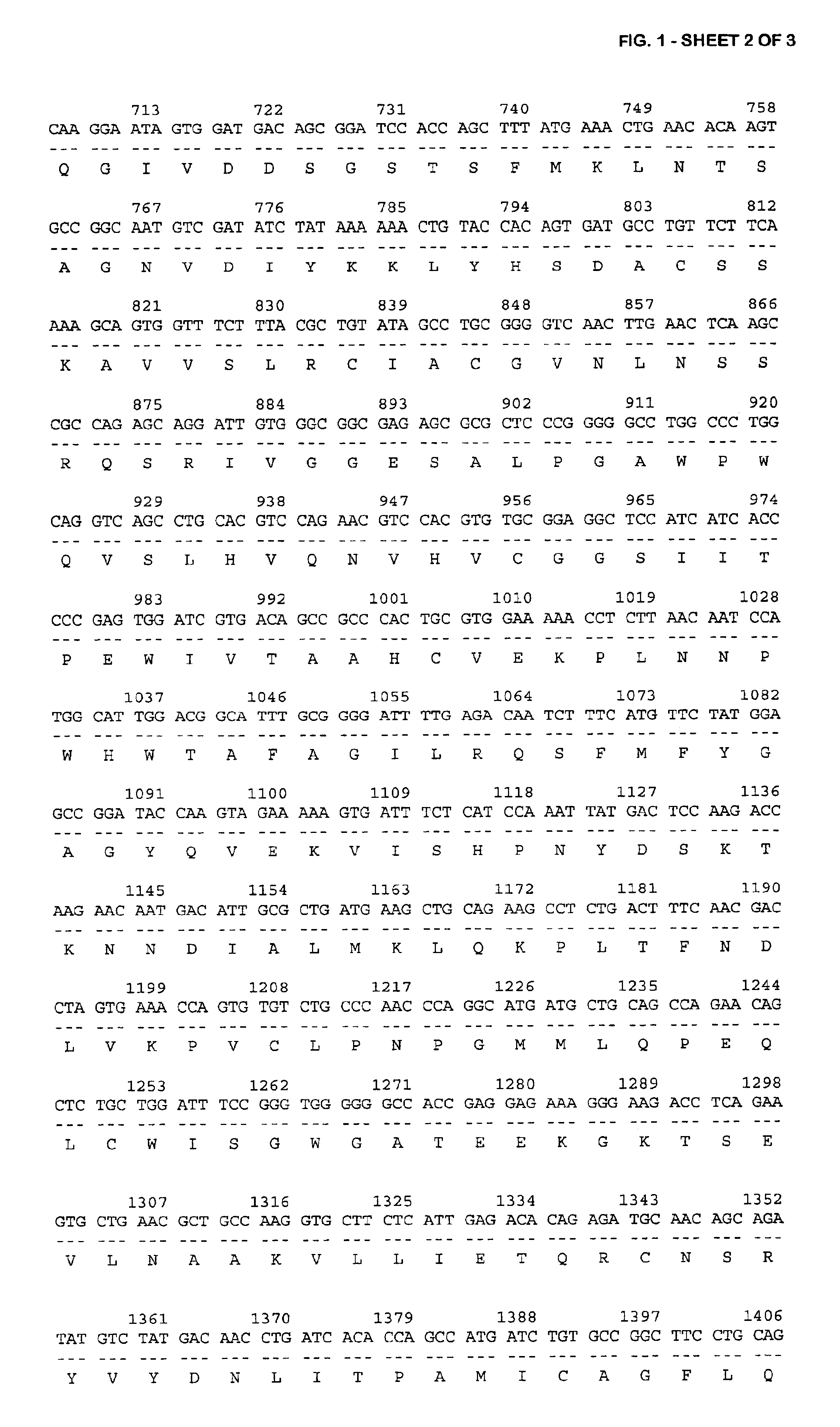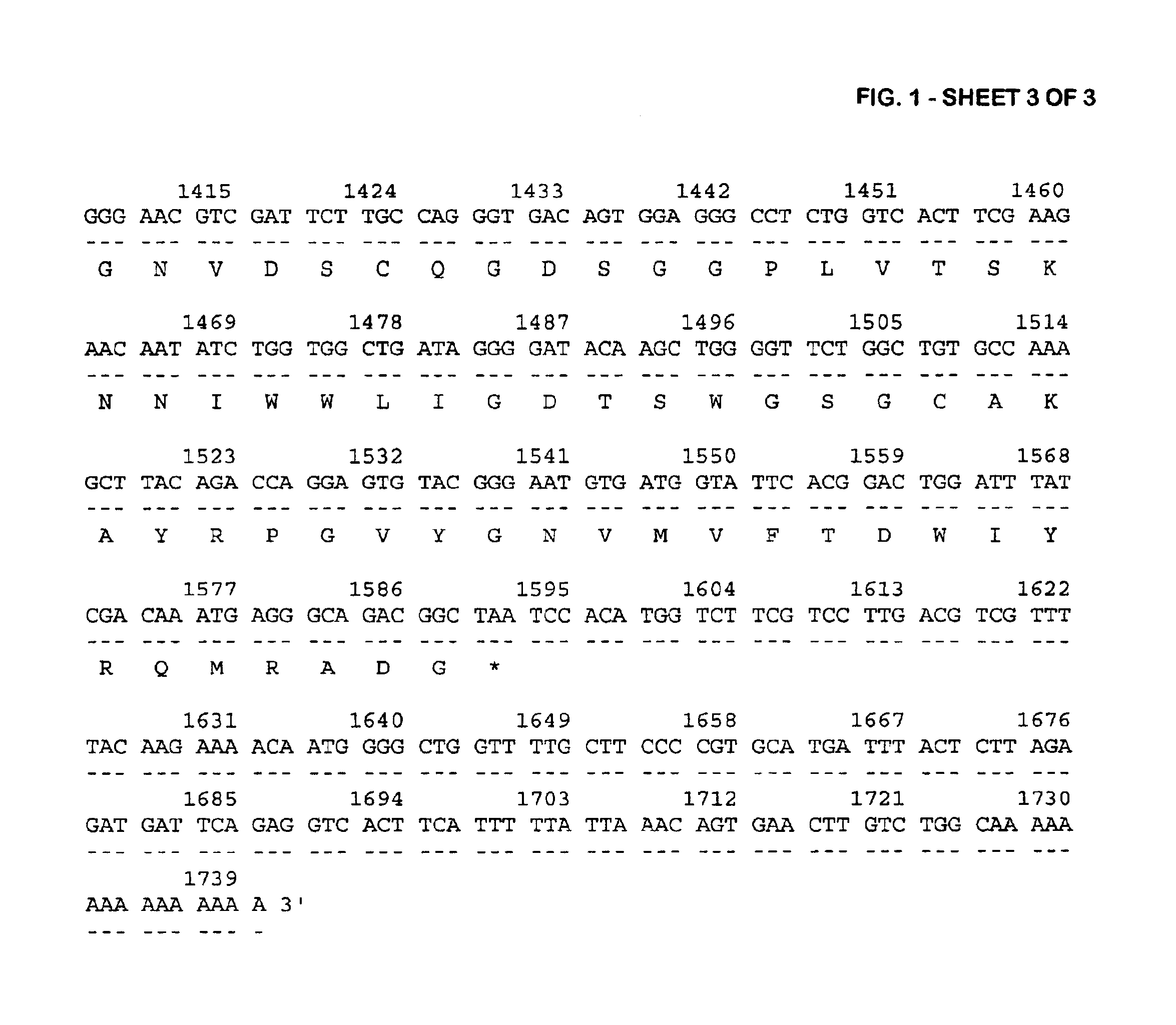Tumor antigen useful in diagnosis and therapy of prostate and colon cancer
a prostate and colon cancer and tumor antigen technology, applied in the direction of instruments, biochemistry apparatus and processes, material analysis, etc., can solve the problems of disease progression and death,/or predict, and inability to reliably detect early-stage localized tumors
- Summary
- Abstract
- Description
- Claims
- Application Information
AI Technical Summary
Problems solved by technology
Method used
Image
Examples
example 1
Isolation of cDNA Corresponding to 20P1F12 / TMPRSS2 Gene by SSH Cloning and Expression Analysis
Materials and Methods
Cell lines and Human Tissues
[0221]All human cancer cell lines used in this study were obtained from the ATCC. All cell lines were maintained in DMEM with 10% fetal calf serum. PrEC (primary prostate epithelial cells) were obtained from Clonetics and were grown in PrEBM media supplemented with growth factors (Clonetics).
[0222]All human prostate cancer xenografts were originally provided by Charles Sawyers (UCLA) (Klein et al., 1997; Craft et al. Cancer Res. 1999 October 1;59(19):5030-6). LAPC-4 AD and LAPC-9 AD xenographs were routinely passaged as small tissue chunks in recipient SCID males. LAPC-4 AI and LAPC-9 AI xenografts were derived as described previously (Klein et al., 1997; Craft et al. Cancer Res. 1999 October 1;59(19):5030-6) and were passaged in castrated males or in female SCID mice.
[0223]Human tissues for RNA and protein analyses were obtained from the Hum...
example 2
Northern Blot Analysis of 20P1F12 / TMPRSS2 Gene Expression
[0254]Northern blot analysis on a panel of 16 normal human tissues using a labeled 20P1F12 / TMPRSS2 probe (corresponding to the 20P1F12 SSH cDNA of FIG. 4) were conducted to confirm the prostate specificity of 20P1F12 / TMPRSS2 expression initially established by RT-PCR expression analysis. The results, shown in FIG. 6 confirm and extended the RT-PCR analyses and show that 20P1F12 / TMPRSS2 expression is relatively prostate specific, as expression in prostate is greater than expression in lung, kidney, pancreas or colon. No detectable expression was observed in any of the other 11 normal tissues used in this panel.
[0255]In addition, 20P1F12 / TMPRSS2 expression levels in the LAPC-4 and LAPC-9 xenografts were also examined by Northern blot analysis. Northern blotting was performed on 10 μg of total RNA prepared from cell lines and LAPC xenografts using random hexamer-labeled (Boehringer Mannheim) 20P1F12 / TMPRSS2 cDNA. The results, sho...
example 3
Cloning of Full Length 20P1F12 cDNA
[0256]A full length cDNA encoding the 20P1F12 / TMPRSS2 gene was isolated from a human prostate library and designated 20P1F12-GTC1. The nucleotide and amino acid sequences of 20P1F12-GTC1 are shown in FIG. 1. Plasmid p20P1F12-GTC1 (carrying the 20P1F12-GTC1 cDNA) was deposited with the ATCC (Manassas, Va.) on Feb. 12, 1999 and has been accorded ATCC Designation Number 207097. The approximately 3.5 kb 20P1F12-GTC1 cDNA encodes a protein of 492 amino acids which is almost, but not completely, identical to the sequence previously described (FIG. 2). There are several differences in the nucleotide sequence of the 20P1F12-GTC1 cDNA relative to the published TMPRSS2 sequence, six of which result in different encoded amino acids, as shown in the amino acid alignment of FIG. 3. Specifically, four of the amino acid differences are in the protease domain, three of which are non-conservative amino acid differences which could affect protease function and / or sp...
PUM
| Property | Measurement | Unit |
|---|---|---|
| pH | aaaaa | aaaaa |
| volume | aaaaa | aaaaa |
| volume | aaaaa | aaaaa |
Abstract
Description
Claims
Application Information
 Login to View More
Login to View More - R&D
- Intellectual Property
- Life Sciences
- Materials
- Tech Scout
- Unparalleled Data Quality
- Higher Quality Content
- 60% Fewer Hallucinations
Browse by: Latest US Patents, China's latest patents, Technical Efficacy Thesaurus, Application Domain, Technology Topic, Popular Technical Reports.
© 2025 PatSnap. All rights reserved.Legal|Privacy policy|Modern Slavery Act Transparency Statement|Sitemap|About US| Contact US: help@patsnap.com



